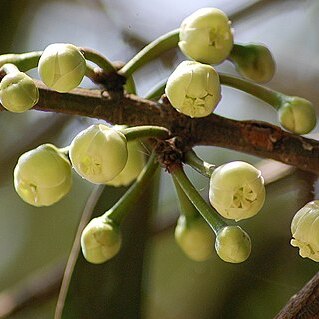Shrub or tree to 7 (–20) m high, dioecous; exudate yellow or milky. Twigs fluted (having decorative grooves), brown to yellow. Leaves glabrous; petiole 10–25 mm long, 5–6 mm wide, ligulate; lamina discolorous, thickly coriaceous, elliptic or ovate or oblong, (12–) 20–32 (–41) cm long, (3.8–) 7.5–12 cm wide, base cuneate or rounded, margin recurved, apex acute, acuminate or apiculate; venation brochidodromous, primary vein slightly raised on upperside and distinctly raised on underside, secondary veins 20–25 pairs, divergence from primary vein 50–60o, prominently or slightly raised above and below; submarginal veins on lamina underside 1–3 mm from the margin. Male inflorescences with 4–8-flowered fascicles. Male flowers (not seen for Australian material) recorded as: 15 mm diam.; sepals 5; petals 5, c. 8 mm long; androecium 5-phalangiate; nectaries in between phalanges. Female inflorescences axillary or ramiflorous, a reduced raceme fascicle-like, 2–14-flowered. Female flowers 10–12(–20) mm diam.; sepals 5, free, suborbicular, 3.5–4 mm long; petals 5, orbicular, 7.5–8 mm long; disk c. 5 mm wide; ovary 5-locular. Fruit a fleshy berry, ovoid or subglobose, apex acute, 30–65 mm long; 30–58 mm wide, yellow or orange; fruiting calyx lobes 5, 3–5.5 mm long.
A tree. It grows 8-15 m tall. The trunk is short and straight. The trunk is 40-50 cm thick. The crown is dense and shaped like a pyramid. The bark is grey-brown. The latex is white and sticky. The branches and leaves often droop. The twigs are angular. The leaves are large. They are 12-24 cm long by 4-7 cm wide. They are shiny above and rough underneath. They are pale green when young. The leaf stalk is 1-2.5 cm long. The male and female flowers are separate. The flowers occur in tufts of 4-10. These are white and about 1 cm across. The fruit is a golden yellow berry. They are 6-9 cm across. The skin is smooth and pale orange to dark yellow. The pulp is yellow, juicy and acidic. It usually contains 1-5 seeds. These are brown and 2.5 cm long.


